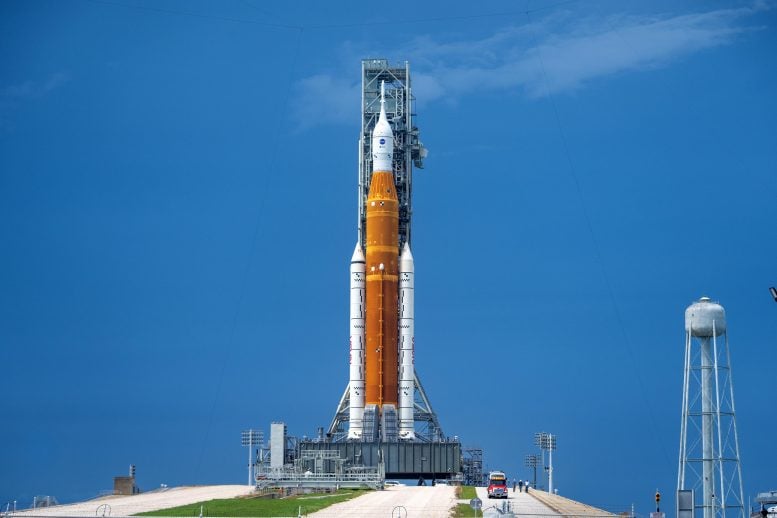
NASA’s Space Launch System (SLS) rocket with the Orion spacecraft aboard is seen atop the mobile launcher at Launch 39B at NASA’s Kennedy Space Center in Florida. Credit: NASA/Steve Seipel
As the countdown continued on Tuesday toward the cryogenic demonstration test, NASA teams conducted final closeouts at the pad and performed other preparations for the test. Work will continue through the night, and all non-essential personnel will leave Launch Pad 39B by 3:40 a.m. EDT (12:40 a.m. PDT) on Wednesday morning. At approximately 7 a.m., the launch director is expected to give a “go” to begin loading cryogenic propellants into the rocket.
Although the countdown clock is ticking down to a simulated liftoff time of 3:40 p.m., the test is planned to conclude around 3 p.m. after the teams have met the objectives. They will not proceed into the terminal count phase of the launch countdown. However, teams may extend the duration of the test should circumstances warrant it.
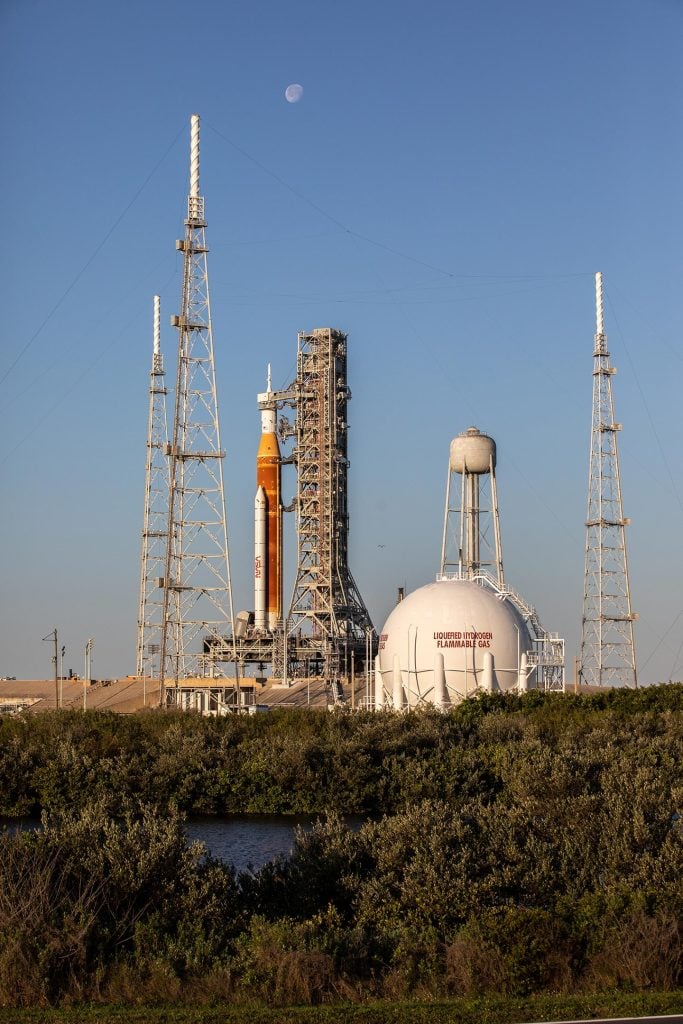
The Moon serves as a background for the Artemis I SLS and Orion spacecraft at Launch Complex 39B at NASA’s Kennedy Space Center in Florida on March 21, 2022. Credit: NASA/Ben Smegelsky
The launch countdown contains “L Minus” and “T Minus” times. “L minus” indicates the time remaining in the scheduled countdown to liftoff in hours and minutes. “T minus” time refers to the time remaining on the official countdown clock and is a sequence of events that are built into the launch countdown. Pauses in the countdown, or “holds,” are built into the countdown to allow the launch team to target a precise launch window, and to provide a cushion of time for specific tasks and procedures without impacting the overall schedule. During planned holds in the countdown process, the countdown clock is intentionally stopped and the T- time also stops. The L- time is synced to the clock on the wall, however, and continues to advance.
Below are some of the key events that take place at each milestone after the countdown begins.
L-9 hours, 40 minutes, and counting
- 6 a.m.: Built-in countdown hold begins (L-9H40M – L-7H10M)
- 6 a.m.: Launch team conducts a weather and tanking briefing (L-9H40M – L-8H50M)
- 7 a.m.: Launch team decides if they are “go” or “no-go” to begin tanking the rocket (L-8H40M)
- 7:25 a.m. Core Stage LOX transfer line chilldown (L-8H15M – L-8H)
L-8 hours and counting
- 7:40 a.m.: Core stage LOX main propulsion system (MPS) chilldown (L-8H – L-7H20M)
- 8:20 a.m.: Core stage LOX slow fill (L-7H20M – L-7H5M)
- 8:20 a.m.: Core Stage LH2 transfer line chilldown (L-7H20M – L-7H10M)
- 8:30 a.m.: Core Stage LH2 slow fill start (L-7H10M – L-6H10M)
- 8:40 a.m.: Core Stage LOX fast fill (L-7H5M – L-4H15M)
- 9:30 a.m.: Core Stage LH2 fast fill (L-6H10M – L-5H5M)
- 9:40 a.m.: Engine bleed kick start (L-6H)
- 10:20 a.m.: ICPS LH2 ground support equipment (GSE) and tank chilldown (L-5H20M – L-5H)
- 10:35 a.m.: Core Stage LH2 topping (L-5H5M – L-5H)
L-5 hours and counting
- 10:40a.m.: Core Stage LH2 replenish (L-5H – Launch)
- 10:40a.m.: Core stage 90-minute bleed valve timer start (L-5H)
- 10:40a.m.: ICPS LH2 fast fill start (L-5H – L-4H)
- 11:25 a.m.: Core stage LOX topping (L-4H15M– L-4H)
- 11:40 a.m.: Core Stage LOX replenish (L-4H – cutoff)
- 11:40 a.m.: ICPS LOX MPS chilldown (L-4H– L-3H45M)
- 11:55 a.m. ICPS LOX fast fill (L-3H45M– L-3H)
- 11:55 a.m. ICPS LH2 tank topping start (L-3H45M – L-2H55M)
L-3 hours and counting
- 12:15 p.m.: ICPS LH2 replenish (L-3H25M – cutoff)
- 12:50 p.m.: Core stage LH2 Pre-press test – ~(L-2H50M) — approximately one hour
- 1:10 p.m.: ICPS LOX topping (L-2H30M – L-2H10M)
- 1:30 p.m.: ICPS LOX replenish (L-2H10M – cutoff)
- 3 p.m.: Cutoff and critical safing (L-40M)

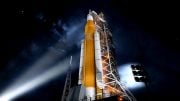
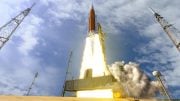

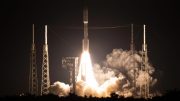
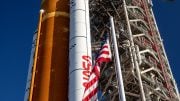
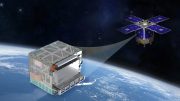
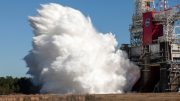
Be the first to comment on "Key Milestones for Today’s NASA Artemis I Demonstration Test"